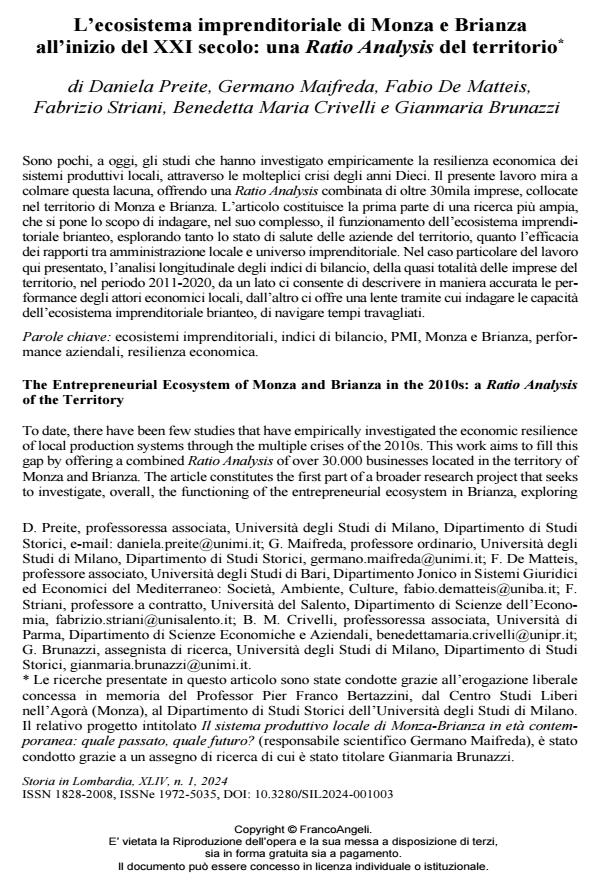L’ecosistema imprenditoriale di Monza e Brianza all’inizio del XXI secolo: una Ratio Analysis del territorio
Titolo Rivista STORIA IN LOMBARDIA
Autori/Curatori Daniela Preite, Germano Maifreda, Fabio De Matteis, Fabrizio Striani, Benedetta Maria Crivelli, Gianmaria Brunazzi
Anno di pubblicazione 2024 Fascicolo 2024/1
Lingua Italiano Numero pagine 35 P. 63-97 Dimensione file 812 KB
DOI 10.3280/SIL2024-001003
Il DOI è il codice a barre della proprietà intellettuale: per saperne di più
clicca qui
Qui sotto puoi vedere in anteprima la prima pagina di questo articolo.
Se questo articolo ti interessa, lo puoi acquistare (e scaricare in formato pdf) seguendo le facili indicazioni per acquistare il download credit. Acquista Download Credits per scaricare questo Articolo in formato PDF

FrancoAngeli è membro della Publishers International Linking Association, Inc (PILA)associazione indipendente e non profit per facilitare (attraverso i servizi tecnologici implementati da CrossRef.org) l’accesso degli studiosi ai contenuti digitali nelle pubblicazioni professionali e scientifiche
Sono pochi, a oggi, gli studi che hanno investigato empiricamente la resilienza economica dei sistemi produttivi locali, attraverso le molteplici crisi degli anni Dieci. Il presente lavoro mira a colmare questa lacuna, offrendo una Ratio Analysis combinata di oltre 30mila imprese, collocate nel territorio di Monza e Brianza. L’articolo costituisce la prima parte di una ricerca più ampia, che si pone lo scopo di indagare, nel suo complesso, il funzionamento dell’ecosistema imprenditoriale brianteo, esplorando tanto lo stato di salute delle aziende del territorio, quanto l’efficacia dei rapporti tra amministrazione locale e universo imprenditoriale. Nel caso particolare del lavoro qui presentato, l’analisi longitudinale degli indici di bilancio, della quasi totalità delle imprese del territorio, nel periodo 2011-2020, da un lato ci consente di descrivere in maniera accurata le performance degli attori economici locali, dall’altro ci offre una lente tramite cui indagare le capacità dell’ecosistema imprenditoriale brianteo, di navigare tempi travagliati.
Parole chiave:ecosistemi imprenditoriali, indici di bilancio, PMI, Monza e Brianza, performance aziendali, resilienza economica.
Daniela Preite, Germano Maifreda, Fabio De Matteis, Fabrizio Striani, Benedetta Maria Crivelli, Gianmaria Brunazzi, L’ecosistema imprenditoriale di Monza e Brianza all’inizio del XXI secolo: una Ratio Analysis del territorio in "STORIA IN LOMBARDIA" 1/2024, pp 63-97, DOI: 10.3280/SIL2024-001003